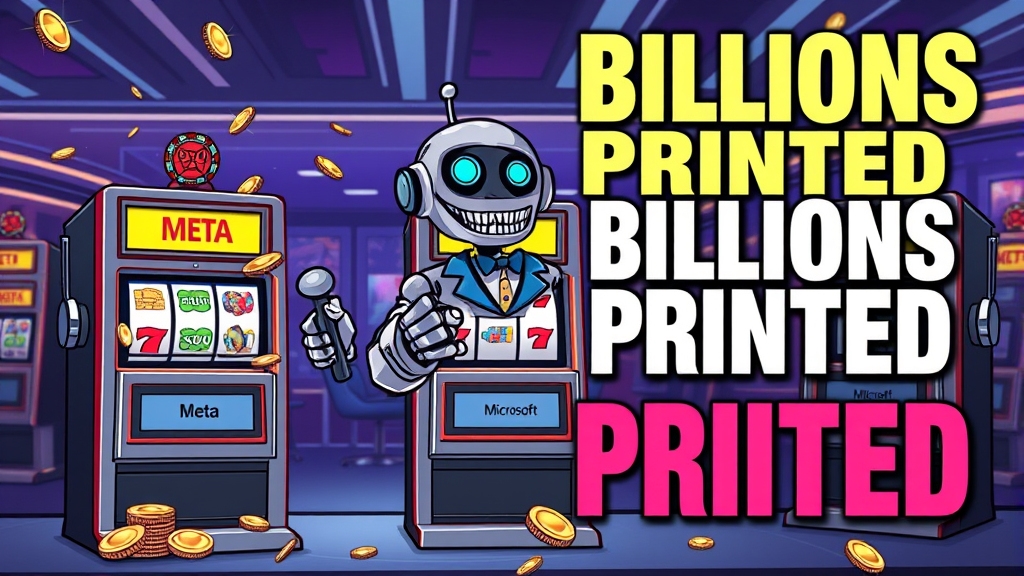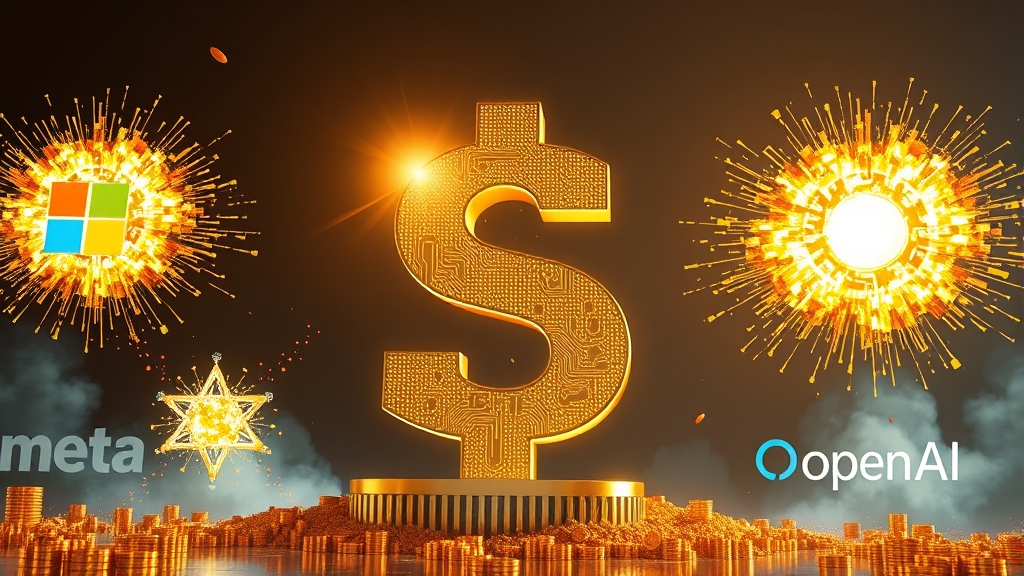The AI bubble everyone keeps talking about? What if it’s not a risk, but the most profitable trend in a generation? While skeptics debate whether AI investments are overheated, companies are quietly printing money at unprecedented rates. Meta just reported $18 billion in quarterly income with 22% revenue growth, directly attributable to AI-powered advertising features.

Microsoft hit $4 trillion in market cap—only the second company ever to reach this milestone—with Azure exploding to $75 billion. And OpenAI? They’re generating $12 billion annually, that’s $1 billion every single month. If you want hard data on AI profits, you’re in the right place—let’s dive into what these numbers really mean for the future of technology.
Meta’s AI-Powered Revenue Machine
Meta’s $18 billion quarterly income represents concrete proof that AI features are converting directly into revenue streams right now. When you examine the mechanics behind this number, you discover that Meta’s 22% revenue growth stems specifically from AI-powered advertising capabilities that extract significantly more value from their existing user base without requiring any behavioral changes from those users. The AI works behind the scenes, making advertisements more relevant, improving targeting precision, and optimizing bid strategies in real-time. As Zuckerberg explained during the earnings call, AI is “unlocking greater efficiency and gains” across their entire advertising system, creating a compounding effect where each AI improvement makes the next improvement more valuable.

Here’s where it gets interesting. Meta doubled their infrastructure spending to $72 billion, and this massive investment isn’t speculative gambling on future AI potential. It’s confident reinvestment of profits that AI features are already generating. But how quickly are those investments paying off? The market’s response tells the real story. Meta’s 10% after-hours surge following their earnings announcement wasn’t speculative enthusiasm about future possibilities. It was validation from investors who can see that AI profitability is happening right now.
Meta’s CFO Susan Lee made a revealing statement about funding most of their infrastructure buildout from existing cash flows. This demonstrates the self-sustaining nature of their AI investments. They’re not borrowing money or issuing debt to fund AI development. The AI features are generating enough additional revenue to pay for their own expansion and improvement. When you track the correlation between AI feature rollouts and advertising revenue spikes, you see measurable returns within quarters, not the typical multi-year investment cycles that characterized previous technology waves.

What does this mean for us as observers of the tech industry? Meta has fundamentally transformed their business model from hoping people show up on their platforms to actively improving how they monetize existing engagement. Their AI doesn’t need more users to generate more revenue. It extracts higher value from every interaction, every ad impression, and every piece of user data. This represents a shift from growth through expansion to growth through optimization.
The implications extend far beyond Meta’s quarterly results. They’ve cracked the code on immediate AI monetization, proving that artificial intelligence investments can generate returns faster than any previous technology wave in history. While other companies debate AI strategies and worry about implementation costs, Meta is already converting AI capabilities into billion-dollar profit increases. This isn’t theoretical anymore. It’s measurable, repeatable, and scalable revenue generation that’s rewriting the rules of technology business models. But Meta isn’t the only tech giant achieving historic milestones through AI-driven growth.
Microsoft’s Historic $4 Trillion AI Achievement
Microsoft just hit $4 trillion in market cap—only the second company ever to cross that line. This historic achievement happened because AI transformed their entire business model in ways that generate measurable returns every quarter. When you examine the timeline, Microsoft’s path to this valuation correlates directly with their AI integration strategy, not traditional growth metrics like user acquisition or product launches.
Early fears of slumping cloud contracts vanished when Azure hit 39% growth to $75 billion, now representing a quarter of Microsoft’s entire business model. This growth rate represents a fundamental shift that happened faster than anyone predicted. Microsoft added more cloud revenue in one quarter than any previous quarter in their company history. We’re talking about growth that’s more than double any previous record they’ve achieved. This isn’t gradual improvement or seasonal variation. This represents a complete acceleration of their revenue generation capabilities driven by enterprise demand for AI-powered cloud services.

When CEO Satya Nadella stated that “cloud and AI being the driving force” of business transformation, he wasn’t delivering marketing speak. The numbers back up this claim with concrete evidence. Microsoft’s company-wide revenue grew 18% while income increased 22%, showing that AI integration creates efficiency gains that translate directly to profit margins. Every AI feature they integrate across their product ecosystem generates measurable financial returns.
And here’s the kicker: that growth puts Azure within striking distance of AWS’s $112 billion business. The gap between them continues to shrink because Microsoft offers AI-driven growth while AWS relies primarily on traditional cloud services. Companies choosing cloud providers increasingly prioritize AI capabilities over basic infrastructure, giving Microsoft a significant competitive advantage.
The market’s response tells us everything we need to know about investor confidence. Microsoft’s 8.5% overnight jump following their earnings announcement demonstrates that investors recognize sustainable, AI-driven growth when they see it. Consider the contrast with Apple’s performance over the same period. Apple’s stock decreased 5% over twelve months while Microsoft achieved historic market cap milestones. The market rewards companies with clear AI strategies and punishes those without measurable AI progress.

Microsoft’s achievement proves something important about AI investments. You can drive a company to historic market valuations through concrete revenue growth, not just investor speculation about future potential. Their $4 trillion market cap reflects actual business transformation, where AI capabilities create new revenue streams and improve existing ones simultaneously.
What’s particularly impressive is how Microsoft achieved this growth across their entire product portfolio. AI isn’t confined to one division or product line. It’s integrated into Office productivity tools, Azure cloud services, Windows operating systems, and enterprise software solutions. This comprehensive approach means every customer interaction has the potential to generate additional value through AI enhancement.
Microsoft has proven that AI can fundamentally reshape a technology company’s financial trajectory within years, not decades. But they’re not the only AI company achieving unprecedented revenue milestones that seemed impossible just months ago.
The OpenAI vs Anthropic Revenue Race

OpenAI just achieved $12 billion in annual recurring revenue, growing from $500 million to $1 billion monthly in less than a year. When you consider that OpenAI started as a research lab focused on AI safety, this transformation represents the fastest revenue scaling in technology history. We’re watching a complete redefinition of how quickly AI companies can generate massive returns.
OpenAI’s 700 million weekly ChatGPT users, up from 500 million in late March, aren’t just using the service more frequently. They represent a monetization engine that’s exceeding every forecast analysts made earlier this year. Each user generates revenue through subscriptions, API usage, or enterprise contracts at rates that traditional software companies never achieved. The numbers tell a story that contradicts everything experts predicted. OpenAI’s revenue trajectory puts them on track to blow past their own $12.7 billion full-year forecast with five months still remaining.
Here’s where the competitive landscape gets interesting. Anthropic has achieved 4x growth in just seven months, closing what was once a 20x revenue gap down to just 2x in three years. We’re watching the most dramatic catch-up story in enterprise software history unfold. While OpenAI built their success on consumer adoption through ChatGPT, Anthropic targeted businesses directly with Claude’s superior capabilities.

This competition proves something important about the AI market. Both companies are demonstrating that the AI market is big enough for multiple $10 billion revenue players. The winner-take-all assumptions that dominated early AI discussions were completely wrong. Companies can specialize in different aspects of AI and still achieve massive financial success.
OpenAI’s $8 billion cash burn increase this year shows how rapid scaling requires massive investment but generates proportional returns. When you’re generating $1 billion in monthly revenue, that investment level becomes sustainable. The cash burn funds infrastructure expansion, research development, and talent acquisition that maintains their competitive advantage.

Insiders say GPT-5 may already outcode Claude in real developer use—what happens if that’s true? The GPT-5 versus Claude competition represents more than feature wars between AI models. It’s about who controls the next phase of AI monetization, particularly in coding applications. The company that dominates coding AI will capture the largest share of enterprise software transformation.
Two different paths—consumer scale and enterprise focus—both proving AI’s market can support multiple multi-billion-dollar players. The OpenAI-Anthropic race demonstrates that AI companies can achieve unprecedented revenue growth rates while maintaining competitive market dynamics. Both companies are rewriting the rules of technology business models, proving that AI investments can generate returns faster than any previous innovation cycle. What we’re seeing here represents something much bigger than individual company success stories.
Conclusion
The evidence is undeniable: we’ve seen billion-dollar months, record-fast capex payback, and competing leaders proving that AI isn’t just hype—it’s the fastest wealth-creation engine ever. Traditional tech companies took decades to reach billion-dollar revenue milestones. OpenAI hit $12 billion annually in just a few years. Anthropic achieved 4x growth in seven months. These numbers force us to reconsider how quickly new technologies can dominate markets and generate massive returns.

But with great profits come great responsibility—watch closely as these companies reinvest trillions into the next frontier of AI. If you want to stay on top of where AI profits—and power—move next, hit subscribe and join the conversation below.









